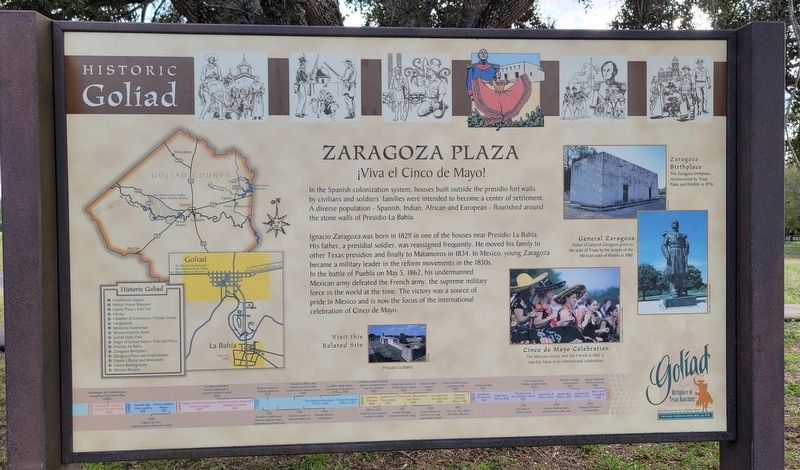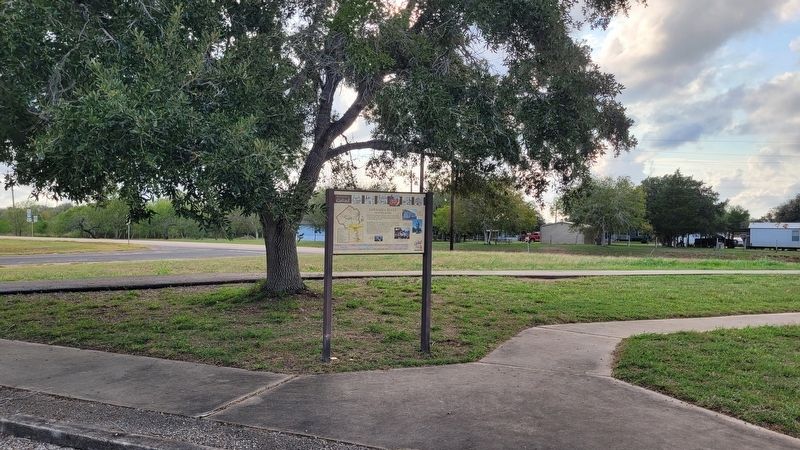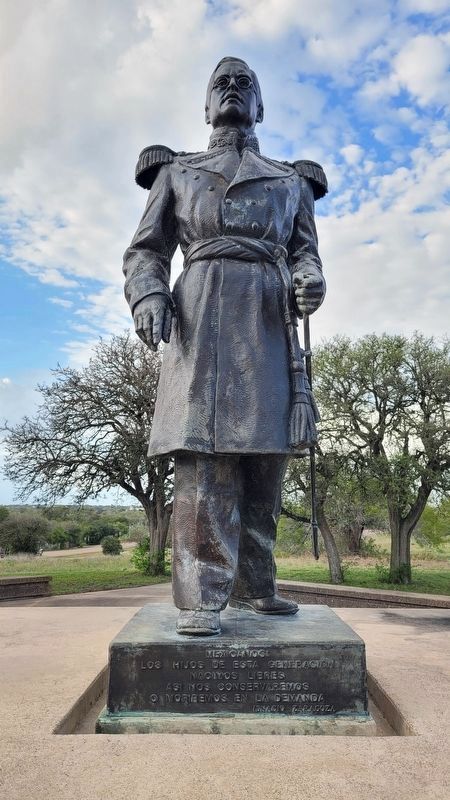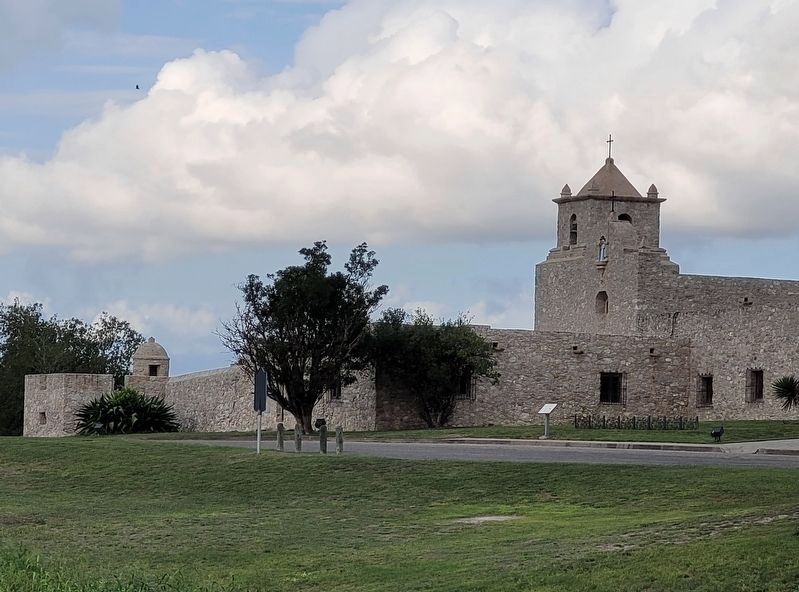Goliad in Goliad County, Texas — The American South (West South Central)
Zaragoza Plaza
¡Viva el Cinco de Mayo!
Ignacio Zaragoza was born in 1829 in one of the houses near Presidio La Bahía. His father, a presidial soldier, was reassigned frequently. He moved his family to other Texas presidios and finally to Matamoros in 1834. In Mexico, young Zaragoza became a military leader in the reform movements in the 1850s. In the battle of Puebla on May 5, 1862, his undermanned Mexican army defeated the French army, the supreme military force in the world at the time. The victory was a source of pride in Mexico and is now the focus of the international celebration of Cinco de Mayo.
Captions
Upper Right: Zaragoza Birthplace
The Zaragoza birthplace, reconstructed by Texas Parks and Wildlife in 1974.
Middle Right: General Zaragoza
Statue of General Zaragoza given to the state of Texas by the people of the Mexican state of Puebla in 1980.
Lower Right: Cinco de Mayo Celebration
The Mexican victory over the French in 1862 is now the focus of an international celebration.
Timeline
1400
1400s Karankawas and Coahuiltecans Occupying Gulf Coastal Plain
1492 Christopher Columbus lands in the New World
1500
1519 Spanish map Texas coastline
1521 Cortez conquers Mexico
1528 Cabeza de Vaca shipwrecked on Galveston Island
1600
1607 English establish Jamestown colony in Virginia
1616 Dutch record first European landing in Australia
1685 La Salle establishes French settlement in present Victoria County
1700
1722 Presidio La Bahía and Mission Espíritu Santo established on French site
1724 Mission moves to Tonkawa Bank site
1726 Mission moves to Mission Valley site
1749 Presidio La Bahía and Mission Espíritu Santo moved to San Antonio River
1754 Mission Rosario established
1775 to 1783 The American Revolution
1779 to 1782 La Bahía cattle drives aid American Revolution
1789 to 1793 French Revolution
1800
1803 Louisiana Purchase
1812 to 1821 Invading forces capture Presidio La Bahia
1823 Austin's first Texas colony
1829 La Bahía renamed Goliad Ignacio Zaragoza born near the presidio
1831 Goliad missions released to local clergy
1835 Goliad Declaration of Independence signed
1836 Texans defeated at Coleto Creek and executed at Goliad
1836 Texas wins independence from Mexico
1836 Goliad County created
1845 Texas becomes the 28th state
1861 to 1865 American Civil War
1862 Cinco de Mayo battle at Puebla, Mexico
1894 Present Goliad County courthouse built
1900
1901 Spindletop oil discovery
1902 Goliad tornado
1914 to 1918 World War I
1929 The New York Stock Market crashes
1929 Oil found in Goliad County
1930s CCC reconstructs Mission Espíritu Santo
1939 to 1945 World War II
1949 Mission Espíritu Santo site becomes a state park
1950 to 1953 Korean War
1965 to 1973 Vietnam War
1967 Presidio La Bahia reconstructed
1974 Zaragoza Birthplace reconstructed
1989 Berlin Wall dismantled
1999 Goliad celebrates 250th anniversary
2000
Erected by Historic Goliad.
Topics. This historical marker is listed in these topic lists: Forts and Castles • Hispanic Americans • Native Americans • Wars, Non-US. A significant historical date for this entry is May 5, 1862.
Location. 28° 38.765′ N, 97° 23.038′ W. Marker is in Goliad, Texas, in Goliad County. Marker is at the intersection of Loop 71 and U.S. 183, on the left when traveling east on Loop 71. The marker is located at the Zaragoza Plaza and statue. Touch for map. Marker is at or near this postal address: 553 Loop 71, Goliad TX 77963, United States of America. Touch for directions.
Other nearby markers. At least 8 other markers are within walking distance of this marker. General Ignacio Zaragoza (a few steps from this marker); Welcome to the Ignacio Zaragoza Birthplace / Bienvenido a la Casa Natal de Ignacio Zaragoza (about 500 feet away, measured in a direct line); A Pitiful Site (about 500 feet away); A Strategic Location (about 500 feet away); a different marker also named General Ignacio Zaragoza (about 600 feet away); Manuel Becerra (about 600 feet away); Presidio La Bahía (about 700 feet away); Presidio la Bahia del Espíritu Santo de Zúñiga (about 700 feet away). Touch for a list and map of all markers in Goliad.
More about this marker. The marker is located on the grounds of the Zaragoza Birthplace State Historic Site.
Also see . . . Zaragoza, Ignacio Seguín (1829–1862). Texas State Historical Association (TSHA)
Ignacio Seguín Zaragoza, Mexican general and hero of Cinco de Mayo, was born on March 24, 1829, at Bahía del Espíritu Santo (see LA BAHÍA) in the state of Coahuila and Texas, near present Goliad, Texas. He was the second son of Miguel G. Zaragoza of Veracruz, Mexico, and María de Jesús Seguín of Bexar, who was a relative of Juan José Erasmo Seguín. With Mexico's defeat in the Texas Revolution, Miguel Zaragoza, an infantryman, moved his family from Goliad to Matamoros, where Ignacio attended the school of San Juan. The elder Zaragoza was transferred to Monterrey in 1844, and Ignacio entered a seminary there. By 1846 he realized that he did not have a strong vocation and left. When the United States invaded Mexico, he volunteered to serve as a cadet in the Mexican army but was rejected. He entered the mercantile business for a short time, and in 1853 he joined the militia of Nuevo León with the rank of sergeant. When his regiment was incorporated into the Mexican army, he was promoted to captain.(Submitted on October 29, 2023, by James Hulse of Medina, Texas.)
Credits. This page was last revised on October 29, 2023. It was originally submitted on October 28, 2023, by James Hulse of Medina, Texas. This page has been viewed 58 times since then and 13 times this year. Photos: 1, 2, 3, 4. submitted on October 29, 2023, by James Hulse of Medina, Texas.



